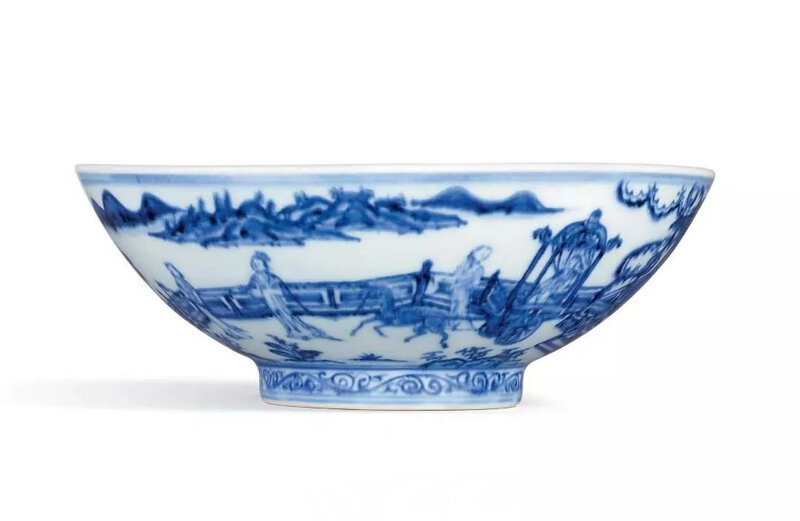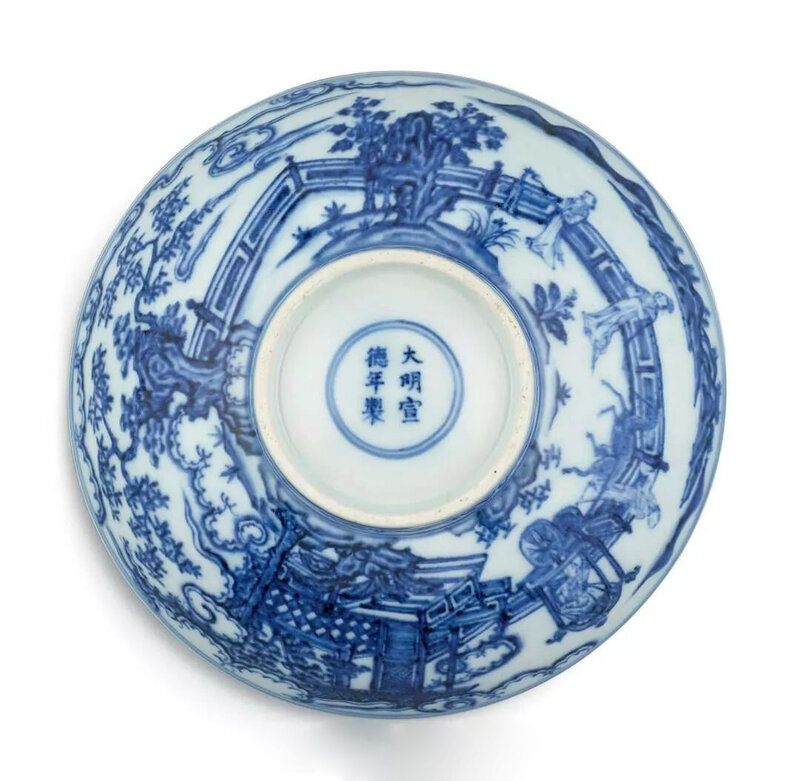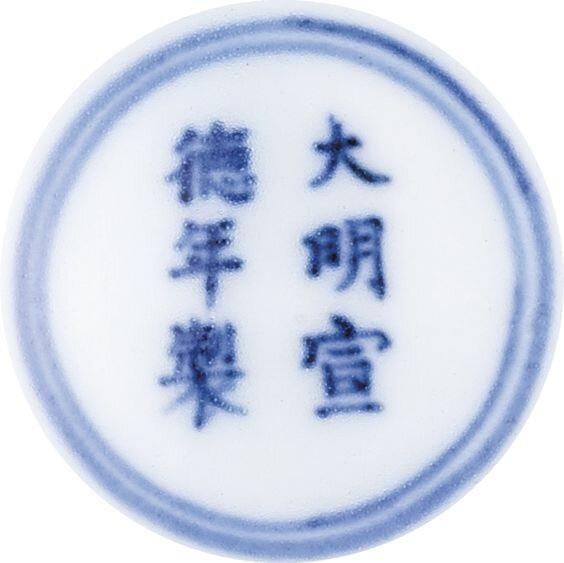Sotheby's. Important Chinese Art from the Collection of Sir Quo-Wei Lee, Hong Kong, 03 oct. 2018, 10:10 AM
A fine and rare Ming-style blue and white 'figures' bowl, Qing dynasty, Kangxi period (1662-1722)
Lot 148. A fine and rare Ming-style blue and white 'figures' bowl, Qing dynasty, Kangxi period (1662-1722); 19.5 cm, 7 5/8 in. Estimate 150,000 — 200,000 HKD (19,110 - 25,480 USD). Lot Sold 18,720,000 HKD (2,387,923 USD). Photo: Sotheby's.
well potted with rounded sides supported on a short foot, the exterior painted in rich cobalt blue with a continuous heavenly landscape scene, depicting a dignitary riding on a chariot, accompanied by three lady attendants, amidst a terraced garden landscape with elaborate pavilions, trees, pierced rockwork, distant mountains and vaporous clouds, the foot encircled by a class scroll band, inscribed to the base with an apocryphal six-character Xuande reign mark within a double circle.
Note: Brilliantly painted in vivid tones of blue with a scene depicting a figure in a carriage and three ladies in flowing robes, this bowl is reminiscent of the classic porcelains from the imperial kiln of the Xuande period. Led by an attendant holding a lantern, the group departs from the pavilion and ventures into a garden full of trees and flowers. The remarkable skills of the artisan are evidenced in the mastery of the brush. Special attention has been given to the jagged garden rocks and the architecture of the pavilion. The two-dimensional curved surface is successfully transformed into a continuous three-dimensional space, expanding beyond the distant mountains, framed but not limited by the passing clouds in the sky.
A closely related bowl of Xuande mark and period, clearly depicting a seated lady in a deer-drawn carriage and an attendant with a qin, in the collection of the National Palace Museum, is included in Catalogue of the Special Exhibition of Selected Hsuan-te Imperial Porcelains of the Ming Dynasty, Taipei, 1998, cat. no. 145. The museum has another bowl of the same design, but with a key-fret border on the foot and further adorned with a medallion of Three Friends of Winter on the interior; see Liao Pao-show, Dianya fuli. Gugong cangci [Elegance and exquisiteness: Porcelains in the collection of the Palace Museum], Taipei, 2013, p. 29, fig. 18, together with the first example, fig. 19.
For Xuande bowls of comparable size but painted with different scenes, see eight other bowls preserved in Taipei and published in Catalogue of the Special Exhibition of Selected Hsuan-te Imperial Porcelains of the Ming Dynasty, op. cit., cat. nos 144, 146-152. The first example, painted with four scenes corresponding to poems from the Tang to Ming dynasty, is also illustrated in Radiating Hues of Blue and White – Ming Dynasty Blue-and-White Porcelains in the National Palace Museum Collection, Taipei, 2015-2016, cat. no. 35. An example from the collections of M.C. Wang, Edward T. Chow, Mathias Komor and Myron S. Falk, depicting an immortal riding on a phoenix, was sold at Christie’s New York, 20th September 2001, lot 134. See also a bowl excavated at the waste heap of the Ming imperial kilns in Zhushan, included in the exhibition Xuande Imperial Kiln Excavated at Jingdezhen, Chang Foundation, Taipei, 1998, cat. no. 104.
Bowls of this shape with figures are believed to be innovations of the Yongle period. A blue and white bowl without reign mark, from the collections of Wu Lai-hsi, Eumorfopoulos and Sedgwick, is now in the British Museum (no. 1968,0422.30) and has been attributed to the Yongle period. Another bowl without mark, formerly in the collections of Frederick M. Mayer and T.Y. Chao Family Foundation, was exhibited in Ming Blue-and-White: An Exhibition of Blue-decorated Porcelain of the Ming dynasty, The Art Institute of Chicago, Chicago, 1949-1950, cat. no. 29 and dated to the early 15th century.
Blue and white bowls with figures, similar to other classic designs originated during the Ming dynasty, enjoyed a renaissance during the early Qing period, when Manchu emperors eagerly attempted to strengthen their rule by utilising classic elements from the past to demonstrate their knowledge of China’s long history. A Kangxi-marked example from the Qing court collection, decorated with the same composition as the British Museum bowl, is preserved in Beijing and illustrated in Gugong Bowuyuan cang Ming chu qinghua ci [Early Ming blue-and-white porcelain in the Palace Museum], Beijing, 2002, vol. 2, cat. no. 181.

/https%3A%2F%2Fprofilepics.canalblog.com%2Fprofilepics%2F1%2F0%2F100183.jpg)
/https%3A%2F%2Fstorage.canalblog.com%2F03%2F02%2F119589%2F96711876_o.jpg)
/https%3A%2F%2Fstorage.canalblog.com%2F11%2F31%2F119589%2F94773502_o.jpg)
/https%3A%2F%2Fstorage.canalblog.com%2F20%2F83%2F119589%2F94772815_o.jpg)
/https%3A%2F%2Fstorage.canalblog.com%2F26%2F72%2F119589%2F75604929_o.jpg)
/https%3A%2F%2Fstorage.canalblog.com%2F59%2F60%2F119589%2F26458628_o.jpg)





/http%3A%2F%2Fstorage.canalblog.com%2F07%2F92%2F119589%2F129516999_o.jpg)
/http%3A%2F%2Fstorage.canalblog.com%2F93%2F15%2F119589%2F121483695_o.jpg)
/http%3A%2F%2Fstorage.canalblog.com%2F94%2F08%2F119589%2F121483548_o.jpg)
/http%3A%2F%2Fstorage.canalblog.com%2F42%2F22%2F119589%2F121444527_o.jpg)